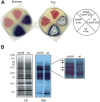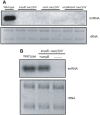The SmpB-tmRNA tagging system plays important roles in Streptomyces coelicolor growth and development
- PMID: 19212432
- PMCID: PMC2635970
- DOI: 10.1371/journal.pone.0004459
The SmpB-tmRNA tagging system plays important roles in Streptomyces coelicolor growth and development
Abstract
The ssrA gene encodes tmRNA that, together with a specialized tmRNA-binding protein, SmpB, forms part of a ribonucleoprotein complex, provides a template for the resumption of translation elongation, subsequent termination and recycling of stalled ribosomes. In addition, the mRNA-like domain of tmRNA encodes a peptide that tags polypeptides derived from stalled ribosomes for degradation. Streptomyces are unique bacteria that undergo a developmental cycle culminating at sporulation that is at least partly controlled at the level of translation elongation by the abundance of a rare tRNA that decodes UUA codons found in a relatively small number of open reading frames prompting us to examine the role of tmRNA in S. coelicolor. Using a temperature sensitive replicon, we found that the ssrA gene could be disrupted only in cells with an extra-copy wild type gene but not in wild type cells or cells with an extra-copy mutant tmRNA (tmRNA(DD)) encoding a degradation-resistant tag. A cosmid-based gene replacement method that does not include a high temperature step enabled us to disrupt both the ssrA and smpB genes separately and at the same time suggesting that the tmRNA tagging system may be required for cell survival under high temperature. Indeed, mutant cells show growth and sporulation defects at high temperature and under optimal culture conditions. Interestingly, even though these defects can be completely restored by wild type genes, the DeltassrA strain was only partially corrected by tmRNA(DD). In addition, wildtype tmRNA can restore the hygromycin-resistance to DeltassrA cells while tmRNA(DD) failed to do so suggesting that degradation of aberrant peptides is important for antibiotic resistance. Overall, these results suggest that the tmRNA tagging system plays important roles during Streptomyces growth and sporulation under both normal and stress conditions.
Conflict of interest statement
Figures









Similar articles
-
Effect of SsrA (tmRNA) tagging system on translational regulation in Streptomyces.Arch Microbiol. 2006 Feb;184(6):343-52. doi: 10.1007/s00203-005-0051-y. Epub 2005 Nov 25. Arch Microbiol. 2006. PMID: 16308686
-
SsrA genes of streptomycetes and association of proteins to the tmRNA during development and cellular differentiation.Proteomics. 2008 Apr;8(7):1429-41. doi: 10.1002/pmic.200700560. Proteomics. 2008. PMID: 18306177
-
Cooperative and Independent Functionality of tmRNA and SmpB in Aeromonas veronii: A Multifunctional Exploration Beyond Ribosome Rescue.Int J Mol Sci. 2025 Jan 6;26(1):409. doi: 10.3390/ijms26010409. Int J Mol Sci. 2025. PMID: 39796263 Free PMC article.
-
The tmRNA system for translational surveillance and ribosome rescue.Annu Rev Biochem. 2007;76:101-24. doi: 10.1146/annurev.biochem.75.103004.142733. Annu Rev Biochem. 2007. PMID: 17291191 Review.
-
Emerging views on tmRNA-mediated protein tagging and ribosome rescue.Mol Microbiol. 2001 Nov;42(4):879-85. doi: 10.1046/j.1365-2958.2001.02701.x. Mol Microbiol. 2001. PMID: 11737633 Review.
Cited by
-
Dual positive feedback regulation of protein degradation of an extra-cytoplasmic function σ factor for cell differentiation in Streptomyces coelicolor.J Biol Chem. 2013 Oct 25;288(43):31217-28. doi: 10.1074/jbc.M113.491498. Epub 2013 Sep 6. J Biol Chem. 2013. PMID: 24014034 Free PMC article.
-
Stalled ribosome rescue factors exert different roles depending on types of antibiotics in Escherichia coli.NPJ Antimicrob Resist. 2024 Sep 2;2(1):22. doi: 10.1038/s44259-024-00039-2. NPJ Antimicrob Resist. 2024. PMID: 39843510 Free PMC article.
-
Release of nonstop ribosomes is essential.mBio. 2014 Nov 11;5(6):e01916. doi: 10.1128/mBio.01916-14. mBio. 2014. PMID: 25389176 Free PMC article.
-
The transfer-messenger RNA-small protein B system plays a role in avian pathogenic Escherichia coli pathogenicity.J Bacteriol. 2013 Nov;195(22):5064-71. doi: 10.1128/JB.00628-13. Epub 2013 Sep 6. J Bacteriol. 2013. PMID: 24013628 Free PMC article.
-
Study of the functionality of the Helicobacter pylori trans-translation components SmpB and SsrA in an heterologous system.BMC Microbiol. 2010 Mar 26;10:91. doi: 10.1186/1471-2180-10-91. BMC Microbiol. 2010. PMID: 20346161 Free PMC article.
References
-
- Karzai AW, Roche ED, Sauer RT. The SsrA-SmpB system for protein tagging, directed degradation and ribosome rescue. Nat Struct Biol. 2000;7:449–455. - PubMed
-
- Withey JH, Friedman DI. A salvage pathway for protein structures: tmRNA and trans-translation. Annu Rev Microbiol. 2003;57:101–123. - PubMed
-
- Wower J, Wower IK, Kraal B, Zwieb CW. Quality control of the elongation step of protein synthesis by tmRNP. J Nutr. 2001;131:2978S–2982S. - PubMed
-
- Richards J, Mehta P, Karzai AW. RNase R degrades non-stop mRNAs selectively in an SmpB-tmRNA-dependent manner. Mol Microbiol. 2006;62:1700–1712. - PubMed
Publication types
MeSH terms
Substances
LinkOut - more resources
Full Text Sources

